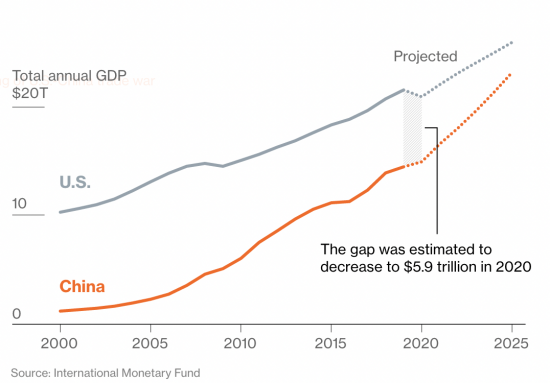Since the 1970s, China has been racing to become the world’s largest economy. This wasn’t obvious when China first began to open its economy with market reforms and consequently began to experience meaningful economic growth. In 2000, China’s GDP was just 11.8% of U.S. GDP. The country had recently launched a private housing market. It became a member of the World Trade Organization in 2001, sparking a decade-long boom as the country urbanized and became the world’s leading goods exporter. Since the global financial crisis in 2007-08, China launched a huge infrastructure investment drive to boost growth. It was able to make up ground rapidly as the U.S. economy contracted (Figure 1)

Figure 1
By 2012, when President Xi Jinping came to power, China’s growth was moderating, partly due to sagging global demand and falling returns on investment. But it still made steady gains on the U.S. each year, with the exception of 2016 when China’s currency depreciated in value.
The coronavirus pandemic is the latest inflection point. China’s faster recovery from the virus meant it increased its share of global output at the quickest pace this century (Figure 2.) Although US, along with most European countries, had a significant contraction of its economy, due to the aggressive fiscal and monetary policy, its economy has shown a strong rebound and is actually larger in size than before the pandemic. Part of the reason China did not experience as much of a contraction and faster rebound than most Western economies is their authoritarian system where they can force their population into extreme lockdowns (not possible in the democratic West!!) and also much more direct intervention by the government into the private sector.

Figure 2
It is clear that China is the only true international competitor to US dominance. Not only are they showing consistent growth over decades, they have been using the resulting wealth to spread their influence around the world. They are increasingly involved in economic and political affairs of countries in the Middle East, Africa, Latin America, and Asia Pacific. Increasingly, their posture is as a counterweight to the American influence in the international sphere. A few years ago, they proposed that their currency be a second international currency, rivaling the dollar. They want to set up new international institutions as an alternative to the World Bank and International Monetary Fund. So, their actions are very deliberate in moving to become the new center of gravity in the world economic and geopolitical affairs.
It has been projected for some time that the total size of their economy will pass US toward the end of this decade or early in the next decade. That projection is based on them continuing to post higher growth rates than most Western economies, including the US. Given the turmoil caused by the coronavirus and the hit to most economies, including the US, China’s economy is now forecast to overtake the U.S. by 2028—two years earlier than expected before the pandemic, according to some predictions.
In order to examine whether that will actually happen and if having the largest GDP in the world will mean being number one in terms of international influence, we will need to examine this topic further.






